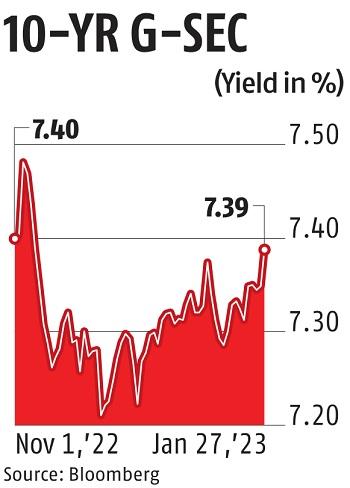10-year bond yield at highest since November on Budget 2023 jitters
Yields on government bonds rose sharply on Friday, with a scheduled primary auction of sovereign debt seeing tepid demand, as market participants braced for the Centre announcing a record-high borrowing programme for the next financial year.
The 10-year benchmark bond yield closed at 7.39 per cent on Friday, four basis points higher than previous close. Bond prices and yields move inversely. A rise of one basis point in the yield on the 10-year paper corresponds to a fall in price of around 7 paise.
Friday’s level marks the highest closing yield for the 10-year benchmark bond since November 7. Intra-day, yield on the 10-year benchmark bond rose to the psychologically significant 7.40 per cent mark.
At Friday’s primary government bond auction worth Rs 30,000 crore, cutoff yields set on the securities were mostly higher than market expectations, indicating weak appetite for bonds, dealers said. The demand for the 14-year bond — of which the government sold Rs 11,000 crore — was particularly on the weaker side, reflecting unease about the prospect of large supply of longer-dated bonds in the next financial year.
According to economists and treasury officials, in the Union Budget, the government is likely to announce gross market borrowing of upward of Rs 15 trillion. That figure, representing the supply of bonds that would hit the market on a weekly basis, will be sharply higher than the current year’s record-high gross market borrowing of Rs 14.3 trillion.
“In FY24, net G-secs issuance is likely to remain elevated at Rs 11.8 trillion vs Rs 11.1 trillion in FY23. The gross issuance is expected at Rs 15.5 trillion, (adjusting for redemption of G-secs issued to fund loans for GST cess revenue shortfall). Gross issuance figure could be further reduced to Rs 15.1 billion (Rs 1,510 crore), building-in switches with the market and the RBI,” IDFC First Bank’s economist Gaura Sen Gupta wrote.

With central banks across the globe, including the Reserve Bank of India, having turned to tighter monetary policies to combat inflation, absorbing such a large supply of bonds could be difficult for the market, treasury officials said. Moreover, the RBI has made it clear that it will turn to durable liquidity infusions only when banks significantly reduce the amount of surplus funds parked with the central bank.
For the moment, therefore, the bond market cannot bank on the RBI picking up some of the large government bond supply through open market operations, which inject durable liquidity into the banking system.
“People are jittery about the borrowing numbers. Moreover, there is an increasingly strong view that maybe the global growth slowdown will not be as bad as earlier expected. This means that interest rates are likely to remain high for long in the US and in general central banks will not immediately move towards a softer policy,” Debendra Dash, chief-dealer, fixed-income, AU Small Finance Bank, said.
 Loan, Personal Loan, Home Loan, Business Loan,Loans in India Loan in India, Personal Loan, Home Loan, Business Loan, Loans in India,Loan Finance,Loan in India, Get Instant Personal Loan,Home Loan, Business Loans in India
Loan, Personal Loan, Home Loan, Business Loan,Loans in India Loan in India, Personal Loan, Home Loan, Business Loan, Loans in India,Loan Finance,Loan in India, Get Instant Personal Loan,Home Loan, Business Loans in India